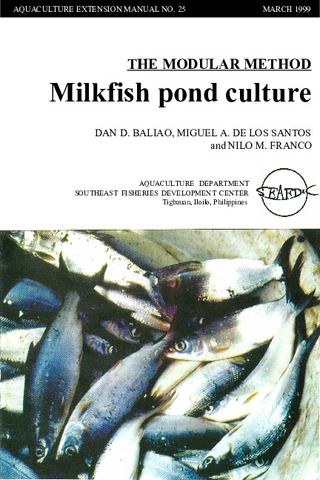Histopathological response of milkfish Chanos chanos Forsskal fingerlings to potassium permanganate
- Global styles
- MLA
- Vancouver
- Elsevier - Harvard
- APA
- Help

View/
Date
1986Page views
2,092ASFA keyword
AGROVOC keyword
Taxonomic term
Metadata
Show full item record
Share
Abstract
Static 96 h bioassays were conducted on milkfish fingerlings at concentrations ranging from 1.00 to 1.80 mg/l KMnO4. Histopathological analyses of gills, liver, and kidney tissues revealed significant changes even in non-lethal concentrations tested. Damage became severe with increasing concentration and longer exposure to the chemical. Partial to complete recovery was observed in gills, liver, and kidney cells of fish exposed to KMnO4 for 96 h and then maintained in KMnO4-free seawater for 240 h.
Suggested Citation
Cruz, E. R., & Tamse, C. T. (1986). Histopathological response of milkfish Chanos chanos Forsskal fingerlings to potassium permanganate. Fish Pathology , 21(3), 151-159. https://doi.org/10.3147/jsfp.21.151
Type
ArticleISSN
0388-788XCollections
- Journal Articles [1258]
Related items
Showing items related by title, author, creator and subject.
-
Series: Aquaculture extension manual; No. 25
The modular method: Milkfish pond culture
Baliao, Dan D.; de los Santos, Miguel A.; Franco, Nilo M. (Aquaculture Department, Southeast Asian Fisheries Development Center, 1999)The modular method of milkfish culture (Chanos chanos) described in the manual is an improvement over the traditional extensive method. The manual is intended for the use of fish farmers and aquaculturists, extensionists, ... -
Evaluation of organic and inorganic fertilizers in brackishwater milkfish ponds
Bombeo-Tuburan, Isidra; Agbayani, Renato F.; Subosa, Precilla F. (Elsevier, 1989)The study was conducted in twelve 144-m2 ponds to evaluate the effect of different organic and inorganic fertilizers on the growth, survival, gross production, and profitability of marketable milkfish. The ... -
Milkfish breeding and hatchery technology at SEAFDEC/AQD
Unknown author (Aquaculture Department, Southeast Asian Fisheries Development Center, 1999)Describes the techniques already adopted by the private sector: broodstock management, broodstock diet, commercial fry production, live transport, and larval diet. A list of AQD research publications on milkfish is included.





